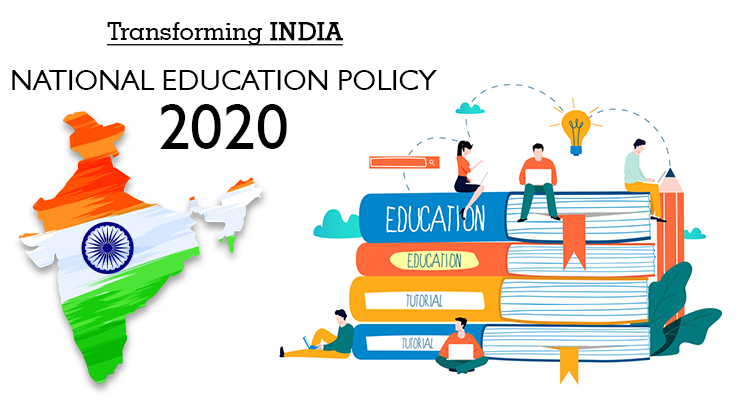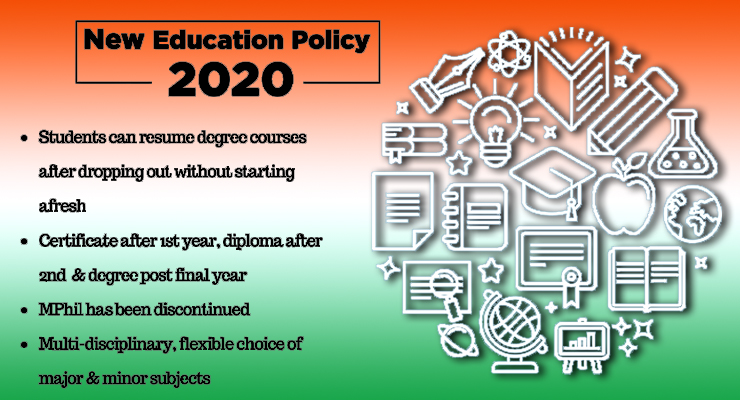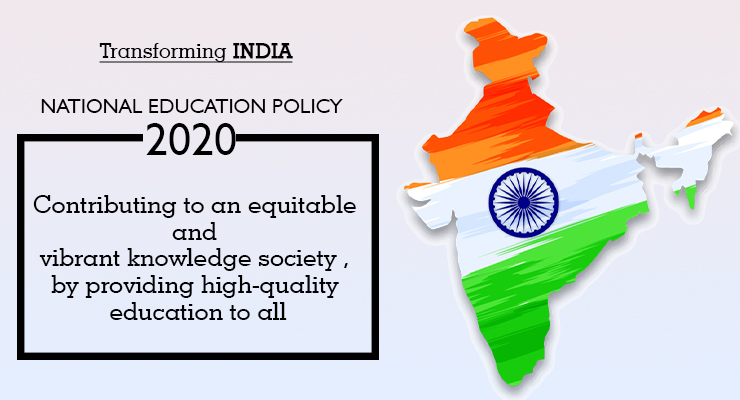Recently the new education policy 2020 has been approved by the Union Government. It replaced a 34 years old National Policy on Education, which was in practice since 1986. Also, the renaming of the Ministry of Human Resource Development is approved, and it has changed to the Ministry of Education.

Aim of the Newly Launched Policy:
The new launch plan aims to create an education policy which can benefit and contribute directly in reforming and transforming the country to a higher level creating the awareness about the education by providing high-quality education to everyone to strengthen and make India a global knowledge superpower.
It focuses on the inclusive and fair education system that can benefit the younger generation by 2030 and to reach 100 per cent literacy rate in India.
It also aims to boost public investment in the Education Sector to attain 6% of GDP.
Early Days:
It was a panel headed by former ISRO chief K. Kasturirangan submitted a draft in December 2018, which was introduced to the public for all the suggestions and feedback just after the Lok Sabha election in May 2019.
After many rounds of discussions and analysing various factors, the new education policy was framed to reform and uplift the policy and change the system of education in India.
Highlights of New National Education Policy 2020:
Universal Access:
The NEP 2020 has provision to maintain and ensure Universal access to school education at all levels ranging from Pre-school to the secondary level of education.
Under this policy it promises to look after infrastructure, innovative education centres to align and bring back dropouts to channel, tracking of students and their learning capabilities, facilitating multiple pathways to learning which included both formal and non-formal educational modes of learning and associating the counsellors or trained social workers for a successful implementation.
The newly crafted policy emphasizes more on open learning for classes 3, 5 and 8 through NIOS State Open Schools, secondary education programs equivalent to Grades 10 and 12, vocational courses, adult literacy and life-enrichment programs which can help in all-round development and create more awareness on the social level.

Early Childhood Care and Education:
The current 10+2 structure of school curriculum is to be replaced by a 5+3+3+4 curriculum structure for the ages ranging from 3 to 8, 8 to 11, 11 to 14, and 14 to 18 years, respectively.
Another important aspect of the new education policy of 2020 is that it will benefit and include the minors of age group ranging from 3 to 6 years and bring them under the school curriculum, which has been understood and recognized globally.
The new education policy will have 12 years of schooling with 3 years of Anganwadi or pre-schooling.
Reaching Foundational Literacy and Numeracy:
The policy focuses on building foundation literacy and numeracy, no segregation between the academic streams, extracurricular, vocational streams in schools.
Vocational education will begin from class 6 with various internship opportunities to strengthen the overall learning foundation.
The MHRD will establish a National Mission on Foundational Literacy and Numeracy. Alongside, a National Book Promotion Policy will also be formulated.
Restructuring School Curricula and Pedagogy:
The school curricula and pedagogy will aim for the overall development of learners by helping them to adapt the key 21st-century skills, shortening the curriculum content to encourage essential learning and critical thinking, providing more focus on experimental learning.
Students will have more flexibility and choice of subjects. Besides this, vocational education will begin in schools from the 6 standard, which also includes internships.
A comprehensive National Curriculum Framework for Teacher Education (NCFTE) 2021, will be designed by the National Council for Teacher Education (NCTE) in consultation with National Council of Educational Research and Training (NCERT).
Multilingualism
The NEP 2020 stresses on using mother tongue, local, regional language as the medium of instruction up to grade 5. Sanskrit to be introduced at all levels of school and higher education as an option for students.
To provide enough flexibility and ease up the process of learning, the language will not be imposed on any student. Foreign languages will also be introduced at the secondary level.
The Rebuilding of Assessment Pattern:
Students will appear for examinations in Grade 3, 5 and 8. Grade 10 and 12 patterns will continue the same, but the learning would focus more on gaining insights rather than grades.
National Assessment Centre, PARAKH (Performance Assessment, Review, and Analysis of Knowledge for Holistic Development) will look after and guide as a standard-setting body.
Fair and Inclusive Education:
The policy encourages funding based on Gender and sanctioning funds for special educational zones for underprivileged groups or regions.
Under this new rule child with disabilities will be given priority to continue their education and take part in the regular schooling process right from the initial stage to higher education, with all the support of educators with cross-disability training, resource centres, accommodations, assistive devices, appropriate technology-based tools and other support mechanisms tailored to suit their needs.
Introduction of Multidisciplinary Education:
The policy at higher education introduces broad-based multi-disciplinary undergraduate education with a flexible curriculum, creative mix of subjects, integration of vocational education and various entries and exit points with certification.
UG education can be of 3 to 4 years with exit options and certification within this time frame. Certification will follow a systematic pattern. Certificate after 1 year, advanced diploma after 2 years Bachelor’s degree after 3 years and Bachelors with research after 4 years.
Also, an academic Bank Credit is to be established for storing the academic credits earned from various institutions digitally so that these can be transferred and considered towards final degree earned.
The Nation Research Foundation will be formed as an apex body for encouraging a research culture and establish a research capability across higher education.
Increasing Gross Enrolment Ratio to 50% by 2023:
NEP 2020 aims to increase Gross Enrolment Ratio in the higher education sector, which includes vocational education from 26.3 per cent (2018) to 50 per cent by 2035. With a wider view to enlarge the sector and quality of education, it is expected to add 3.5 crores additional seats to higher education institutions.
Regulation- Higher Education Commission of India (HECI) will look after as a single governing body entire higher education, excluding medical and legal education.
Higher Education Commission of India (HECI) will fully function and rights to penalise higher education institutions for not following norms and standards.

Rationalised Institutional Architecture:
Affiliation of various colleges is to be carried out in 5 years, followed by implementing a stage-wise process involved for granting graded autonomy to colleges.
It is expected that over a period of time every college would consequently turn into an autonomous degree-granting college or a constituent college of a university.
Financial Assistance for Students:
The Nation Scholarship Portal will work towards supporting, fostering and tracking the performance of students receiving scholarships.
Private HEIs will also be encouraged to offer larger numbers of free ships and scholarships to their students for all round development.
Open and Distance Learning:
Various measures such as online and digital courses, funding for research, nurture student services, credit-based recognition of MOOCs will be given attention to make sure it is at par with the finest quality in-class programmes.
Online and Digital Education:
A unit focused on building digital infrastructure, digital content and capacity building will be created in the MHRD to take care of the e-education requirements of both schools and higher education.
Promotion of Indian Languages:
NEP promises to set up an Indian Institute of Translation and Interpretation (IITI), National Institute (or Institutes) for Pali, Persian and Prakrit, encourages to implement Sanskrit and all language departments in HEIs and also understands the need to use mother tongue or local language as a medium of instruction in HEIs programmes.
Professional Education:
All professional education will be an important part of the higher education system. Stand-alone technical universities, health science universities, legal and agricultural universities will merge and come as one powerful unit.
Rise of Education Policy:
University National Policy on Education, 1968
42nd Constitutional Amendment, 1976- Education in Concurrent List
National Policy on Education (NPE), 1986
National Policy on Education, 1968
42nd Constitutional Amendment, 1976- Education in Concurrent List
National Policy on Education (NPE), 1986
Education Commission (1948-49)
Secondary Education Commission (1952-53)
Education Commission (1964-66) under Dr D. S. Kothari